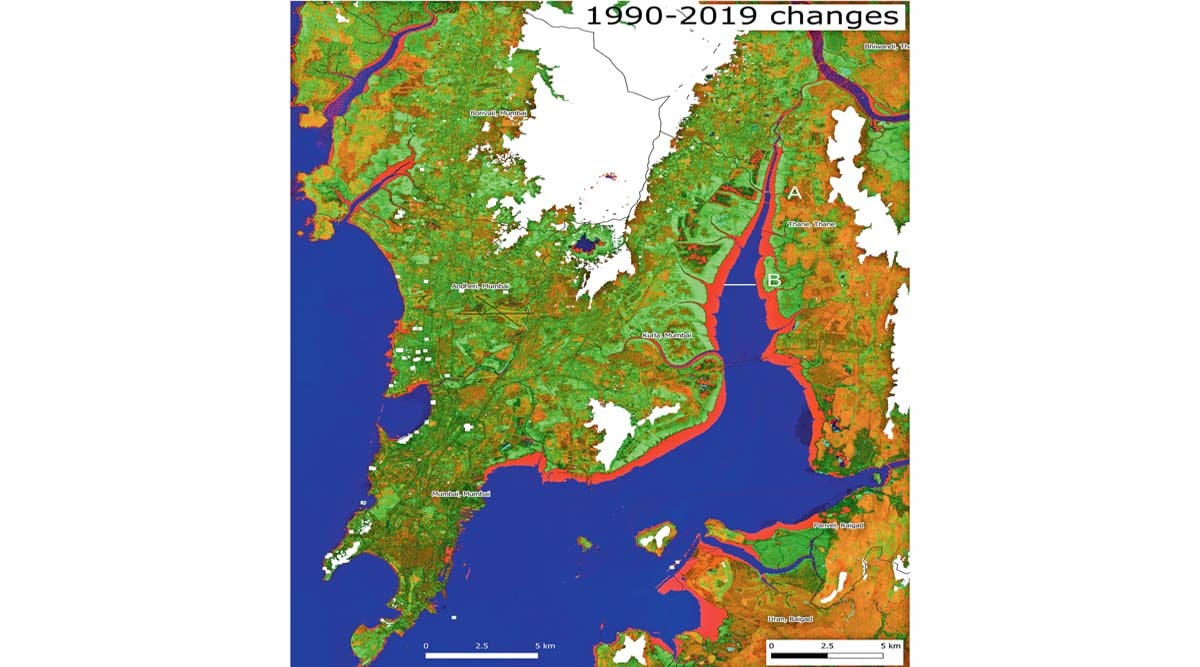 Changes for waterways across MMR (marked in red) from 1990 to 2019.
Changes for waterways across MMR (marked in red) from 1990 to 2019. Between 1990 and 2019, Mumbai Metropolitan Region (MMR), including Mumbai, Thane, Navi Mumbai and Uran, has lost around 107 sq km of creek and agricultural land to siltation, according to an ongoing study by a Pune-based non-profit organisation, Srushti Conservation Foundation (SCF).
Siltation leads to formation of mudflat and growth of mangroves. An increase in mudflats along creeks could eventually slow down flow of rainwater and worsen waterlogging during monsoon, along with clogging drainage systems and hampering intertidal flow. Dumping of unauthorised solid waste and construction debris are some reasons behind the expansion of mudflats. Creeks are important as they flush out the city’s domestic sewage and industrial effluents into rivers and, ultimately, into the sea. The SCF, founded by marine biologist and former director of Bombay Natural History Society director Deepak Apte earlier this year, assessed satellite data between 1990 and 2019 to study changes along the coastline in MMR.
The siltation at the mouth of the creeks has led to shrinking and even shallowing, thus, reducing the capacity of carrying floodwater, especially during high tide. This puts coastal areas at risk of increased inundation, especially during the monsoon. “Due to the shrinking creek, drainage capacity during the monsoon will reduce significantly leading to excessive flooding for this region. Once it becomes shallow, the water carrying capacity of the creek will be reduced. As a result, during heavy rain and high tide, water will enter city spaces with a subtle increase in sea-level rise scenario,” said Dr Deepak Apte, executive director SCF.
The study has found that approximately 47 sq km of waterways were replaced along Mumbai-Thane creek by land (mangrove/mudflats) with 24 sq km alone along Thane creek.
An increase in mudflat areas, especially near Thane creek, has seen a gradual increase in the number of flamingos visiting the site. Average flamingo numbers gradually increased from a few thousand to 20,000 between 1995 and 2005 and then shot up, touching 1,20,000 by 2019. The change, however, may be short-lived, stated the study. Once the accreted land is taken over by mangroves in combination with the reduction in tidal prism during non-monsoon months, soft mudflats turn into hard and barren land. “Thus, flamingos will permanently move away from such habitats,” Apte said.
“Considering the seriousness of this issue, where the width of creek areas is reducing owing to excess siltation, scientific removal of mangroves will have to be carried out to protect the original coastline. The findings of this study seem to be accurate as the mangrove cell has also conducted a similar internal satellite mapping study of Thane creek, which shows a tremendous rise in mangroves with the width of these waterways decreasing. We are fine-tuning this report, and it will be published soon,” said Virendra Tiwari, additional principal chief conservator of forest (mangrove cell) and executive director, Mangrove Foundation.
In 2019, the foundation prepared a proposal to cut the mangroves that had grown inside Thane creek. The proposal is awaiting approval from the state department. The SCF is building satellite datasets for 15 to 20 locations across the Maharashtra coastline, working over this year to bring out a comprehensive report to aid policymakers on the issue of coastal inundation and land degradation.
- The Indian Express website has been rated GREEN for its credibility and trustworthiness by Newsguard, a global service that rates news sources for their journalistic standards.

